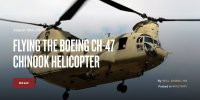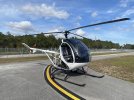You are using an out of date browser. It may not display this or other websites correctly.
You should upgrade or use an alternative browser.
You should upgrade or use an alternative browser.
Helicopters on this forum?
- Thread starter 4RNB
- Start date
Sierra_Hotel
Cleared for Takeoff
- Joined
- Oct 30, 2019
- Messages
- 1,100
- Display Name
Display name:
Sierra_Hotel
R44
texasclouds
En-Route
Ewww, gross! Egg beaters are prohibited here. J/K
- Joined
- Jul 3, 2012
- Messages
- 15,597
- Display Name
Display name:
Velocity173
Brad Z
Final Approach
If you can find one, a Bell 47 would fit the bill. Not too many left in flight training these days, however.
- Joined
- May 24, 2016
- Messages
- 961
- Display Name
Display name:
4RNB
Well that picture does not give me enough info to learn. My read of the N# takes me to a Kodiak fixed wing...Plenty of room. Only does a little over 80 kts on a good day but is still a blast to fly NOE with doors off.
View attachment 123141
If you can find one, a Bell 47 would fit the bill. Not too many left in flight training these days, however.
The best course of action would be to buy one. In my opinion the Bell 47 is a great helicopter to learn in and would be pretty gentle on the pocketbook for low use personal ownership. Parts a are getting harder to come by however, so I would want to work with an experienced mechanic to care for it. Hence my original suggestion to find a local guy to help influence a decision.
The only problem I see with learning to fly in a B47 is that it'll likely spoil you.
- Joined
- Jun 11, 2015
- Messages
- 4,113
- Display Name
Display name:
Piperonca
Well that picture does not give me enough info to learn. My read of the N# takes me to a Kodiak fixed wing...
Home - Schweizerrsg
Morgan3820
Ejection Handle Pulled
A thousand parts moving in harmony. Two suddenly disagree and, well...
Klaus M
Pre-takeoff checklist
- Joined
- Jun 11, 2015
- Messages
- 4,113
- Display Name
Display name:
Piperonca
Bart Kelly at Bell Helicopter was a very tall guy. He directed the cockpit design of the 47 and as a result the cyclic control was higher than normal. For big pilots it’s ideal.The best course of action would be to buy one. In my opinion the Bell 47 is a great helicopter to learn in and would be pretty gentle on the pocketbook for low use personal ownership. Parts a are getting harder to come by however, so I would want to work with an experienced mechanic to care for it. Hence my original suggestion to find a local guy to help influence a decision.
The only problem I see with learning to fly in a B47 is that it'll likely spoil you.
- Joined
- Jul 3, 2012
- Messages
- 15,597
- Display Name
Display name:
Velocity173
Schweitzer 300. Army used them (TH-55) with guys 6’4” so it’s doable. Might have to tilt your head slightly forward. Don’t know how much 300 lbs would affect W&B though.Well that picture does not give me enough info to learn. My read of the N# takes me to a Kodiak fixed wing...
Tall Helicoper Pilots
Question for the board I'm 6'4" and looking at helicopter flight training. I was wondering if any other tall pilots here could help me in choosing the right helicopter to train in. I know the R-22 is the standard today, but I fear I maybe too tall to fit inside. If anyone here has trained in this...
helicopterforum.verticalreference.com
Spring Ford
Line Up and Wait
- Joined
- Jul 11, 2018
- Messages
- 773
- Display Name
Display name:
SpringFord
the helicopter market is pretty small and I've never seen much online.
pprune.org has a helicopter section.
Rotorheads - PPRuNe Forums
Rotorheads - A haven for helicopter professionals to discuss the things that affect them
www.pprune.org
Don't worry too much about the "professional" tags. In the heli section all aviators and prospects seem welcome. Just don't post photos of your first solo in the main "Rumours and News" forum.
Bit of a UK lean I guess however there is plenty US and other international inputs. Maybe try posting your question there.
Last edited:
“Hogg, just get away from that thing…”
-Skip
-Skip
luvflyin
Touchdown! Greaser!
What's NOE?Plenty of room. Only does a little over 80 kts on a good day but is still a blast to fly NOE with doors off.
View attachment 123141
k9medic
Line Up and Wait
- Joined
- Sep 27, 2018
- Messages
- 920
- Display Name
Display name:
ATP-H, CMEL, CSEL, CFI/CFII Airplanes and Helicopters
Nap of the Earth - i.e. low level flying.
The Hughes 300/ TH55 is accommodating to pilots up to around 6'7". Lateral CG in them might be a bit of an adjustment but you will not be forward CG.
The Hughes 300/ TH55 is accommodating to pilots up to around 6'7". Lateral CG in them might be a bit of an adjustment but you will not be forward CG.
I feel like R44’s have become the industry’s gold standard for multipurpose rotorcraft operations.
Depends how deep you want to go down that rabbit hole. But I usually recommend looking for a local ops that offers helicopter discovery flights.Where do I go to obsess over helicopters?
Last one I arranged cost $200 in an R44 and had a mini-ground school and 40 mins actual flight time. After that then you can see how obsessed you really are.
It depends which part of the industry. For training, yes.I feel like R44’s have become the industry’s gold standard for multipurpose rotorcraft operations.
- Joined
- Jul 3, 2012
- Messages
- 15,597
- Display Name
Display name:
Velocity173
pprune.org has a helicopter section.
Rotorheads - PPRuNe Forums
Rotorheads - A haven for helicopter professionals to discuss the things that affect themwww.pprune.org
Don't worry too much about the "professional" tags. In the heli section all aviators and prospects seem welcome. Just don't post photos of your first solo in the main "Rumours and News" forum.
Bit of a UK lean I guess however there is plenty US and other international inputs. Maybe try posting your question there.
I’m aware of that one. Perhaps I wasn’t clear in my comment but my point was that the market is much smaller so don’t expect the same volume of online activity that you’ll see for airplanes.
I found that talking to a couple local operators much more fruitful when I was starting out.
luvflyin
Touchdown! Greaser!
But what is the acronym?Mostly contour here with a small taste of NOE.
EDIT: Got it, Nap Of Earth. Thx piperonica
Capngrog
Pre-takeoff checklist
I understand why pilots like and use acronyms (writing down clearances, taxi instructions etc.), and why so many acronyms are just made up on the spot by creative aviators; however, some acronyms are a bit of a puzzle to sort out into any meaningful communications.
I'm 6' and 195# and doing a helicopter add-on now.
The R22 would be solo only with minimum fuel, Not a good option at all.
The R44 would fit you well, but pricy as a rental. Very fun, not too practical. Ranks up there with ASES for fun though (but a lot harder).
No idea on the other options.
The R22 would be solo only with minimum fuel, Not a good option at all.
The R44 would fit you well, but pricy as a rental. Very fun, not too practical. Ranks up there with ASES for fun though (but a lot harder).
No idea on the other options.
Witmo
Pattern Altitude
- Joined
- Feb 19, 2006
- Messages
- 2,434
- Display Name
Display name:
Tim
You probably have never served in the military. Each service has a huge list of acronyms unique to itself. I left my first joint service meeting not having a clue about half of what was said. My supervisor said not to worry as I would eventually learn. I was once tasked to go through a briefing and write down every acronym and spell out what each stood for. I was told to stop after I had twenty pages (I wasn't finished) --it was a very long briefing to general officers of every service.I understand why pilots like and use acronyms (writing down clearances, taxi instructions etc.), and why so many acronyms are just made up on the spot by creative aviators; however, some acronyms are a bit of a puzzle to sort out into any meaningful communications.
- Joined
- Jun 11, 2015
- Messages
- 4,113
- Display Name
Display name:
Piperonca
My acronym googling turned up American Shoulder and Elbow Surgeons (ASES), then finally Airplane Single Engine Sea. Getting old I guess. First sign is AF (acronym fade).Ranks up there with ASES...
Capngrog
Pre-takeoff checklist
You probably have never served in the military. Each service has a huge list of acronyms unique to itself.
I served four years three months and three days in "Uncle's Airplane"(USAF) and had my enlistment extended to go over seas.
- Joined
- Feb 28, 2013
- Messages
- 1,724
- Display Name
Display name:
Warlock
I was part of DAST’s (Dedicated At Sea Test) to write a DOD manual on utilizing Army Aircraft on Navy ships…part of the exercise was trying to capture Navy vs Army speak…the manual was never published. My prior experience with Navel ops made me a center point. We flew a lot but in general it’s hard to understand why why this would ever be a good idea in practice…on paper it was a good but AH-64’s and CH-47’s just have so many issues operating off a LHA’s, even worse on smaller 2 spot ships. We went to sea seven times during this testing.
Witmo
Pattern Altitude
- Joined
- Feb 19, 2006
- Messages
- 2,434
- Display Name
Display name:
Tim
Thank you for your service. My point is that all the services have unique acronyms and what's understood in one is greek to another. Until you get deal closely with the other services you don't realize it's like learning a new language.I served four years three months and three days in "Uncle's Airplane"(USAF) and had my enlistment extended to go over seas.
Reminds me of the boatload of Army Air Force B-25s on the USS Hornet. Historians tell us that the Navy guys were kind of discouraged when they thought it was just a transport mission. I don't know if they had any difficulties with service-specific acronyms, but the cheer that went up when the commanding officer announced "This force is bound for Tokyo" suggests that everyone understood what THAT meant.I was part of DAST’s (Dedicated At Sea Test) to write a DOD manual on utilizing Army Aircraft on Navy ships…part of the exercise was trying to capture Navy vs Army speak…the manual was never published. My prior experience with Navel ops made me a center point. We flew a lot but in general it’s hard to understand why why this would ever be a good idea in practice…on paper it was a good but AH-64’s and CH-47’s just have so many issues operating off a LHA’s, even worse on smaller 2 spot ships. We went to sea seven times during this testing.





